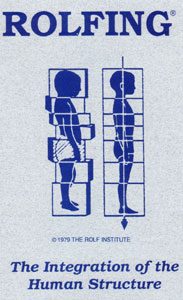History & Practice of Rolfing
 The Dr. Ida Rolf Institute’s “little-boy” logo is based on actual before and after Rolfing sessions of a four-year old boy with Dr. Rolf. The child, Tim Law, was diagnosed by doctors as suffering from Legg-Perthes disease: doctors were certain that by the time he was 20, he would be confined to life in a wheelchair.
The Dr. Ida Rolf Institute’s “little-boy” logo is based on actual before and after Rolfing sessions of a four-year old boy with Dr. Rolf. The child, Tim Law, was diagnosed by doctors as suffering from Legg-Perthes disease: doctors were certain that by the time he was 20, he would be confined to life in a wheelchair.
His mother made a difficult yet courageous decision in 1959 to have Dr. Rolf work with her son, instead of following the doctors’ advice to put him in a cast for five years. The last 46 years have borne out the correctness of her decision: Tim went on to be a champion surfer in high school and college, father of two children, and live a happy and fulfilling life until his passing in 2017.
Rolfing®
Rolfing is a whole-body system of health care originated by and named for Ida P. Rolf, Ph.D. Rolfing focuses on the structure of the body, with the intention of releasing the body from lifelong patterns of tension. The release allows gravity to realign the segments and balance the body.
Rolfing is performed in a series of ten distinct sessions, each an hour to an hour and a quarter long. The Rolfer uses physical pressure (with hands and fingers) to lengthen and return the body’s connective tissue to its original symmetry and balance. The aim is to achieve the optimal alignment for that person. This whole-body treatment is necessary in order to enable the changes to be integrated throughout. This gives a lasting stability, with no need for constant return visits.
Dr. Rolf referred to her work not as “Rolfing,” but as “Structural Integration,” and her goal was exactly that: integration of the structure of the body. Rolfing is guided by three simple ideas concerning the human structure:
- We function much better when we are lined up with the earth’s gravitational field,
- The majority of human beings are significantly out of alignment with gravity, and
- The human body is so changeable that it can be brought into balance with gravity at practically any point in one’s life. (read more on gravity and Rolfing®)
This ability to change is a quality of fascia, a connective tissue studied by Dr. Rolf while working as a research scientist with the Rockefeller Institute. Fascia envelops muscles and organs and gives the body its shape. Her discovery was that if specific kinds of pressure were applied to fascia, the body shape will change in a lasting way. The body is changeable, a plastic medium.
To illustrate the possible consequences of the body’s changeability, consider a twisted ankle. The connective tissue in the affected ankle area will shorten and thicken (for support) while the body must limp temporarily. Meanwhile, the shifting of weight to the other strong leg restructures muscular action in the legs, as well as in the pelvis, up the spine, and eventually throughout the body. Although the limp disappears as the injured ankle strengthens again, the overall holding pattern in the muscles and tissues continues. As time goes by, the pelvis continues to tilt, the lower back becomes painful, and tensions and pains appear in the body without any obvious reason. The person is left with an ever-increasing distortion.

The same body response occurs with all types of emotional and physical traumas, as well as inefficient patterns of behavior and movement. Each experience is stored somewhere in the body in the form of contraction, locked joints, and/or painful spots.
One individual may perceive this gradual misalignment of structure as a sharp pain in the back, another as the unflattering contour of the belly. For someone it may show up as constant fatigue, and yet another as permanent anxiety or depression. All these symptoms point to a single problem: THE BODY IS OUT OF BALANCE.
“Rolfing®” and “Rolfer®” are registered service marks of the Dr. Ida Rolf Institute for Structural Integration, Boulder, Colorado and may be used only with its permission.
Ready to find out more?
Free your body’s soft tissues tensions, to allow your structure to naturally stand up straight.
